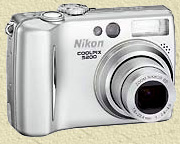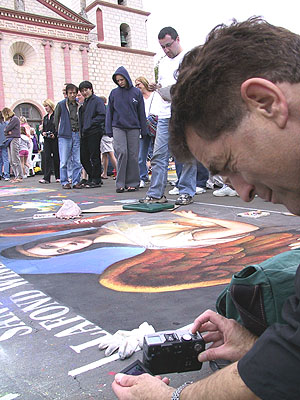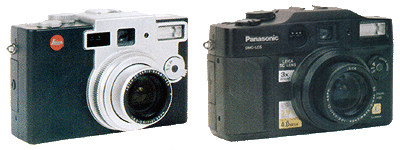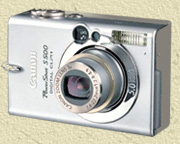|
Pocket-Sized Wonders
My sister Alicia simply adores her Canon Powershot S500, while I bring along my trusty Nikon CoopPix 5200 when I can do without the weight, bulk or conspicuity of my SLRs. These two petite cameras feature 1/1.8" CCD sensors with 5.0 megapixels, 3x optical zoom, multiple preset automated modes, manual exposure control, red-eye reduction, PictBridge printing, and movie capture. As of Fall 2004, each is priced near $400 before promotional savings. |
|
|
The S500 is just a tad more sophisticated, with its slightly wider lens (7.4mm as opposed to 7.8mm), faster processor, one-button screen-off switch, and more compact dimensions. The 5200, utilizing the slimmer Secure Data memory card instead of the older Compact Flash used in the S500, is lighter by a little more than an ounce (5.5 oz). |
 |
 |
Canon PowerShot G-Series The main attraction of the annual I Madonnari festival, at the steps of the Mission Santa Barbara, California, is the rendition of Italian renaissance masterpieces as billboards of local organizations and businesses, drawn in chalk on pavement. Here, fellow digital photographer Michel took a very low-profile shot with the same camera model I used to take the picture seen at left on the 26th of May, 2002: the Canon Powershot G1. It was my third digital camera since 1998, an upgrade from the Canon Pro70. My anxiety over its thin plastic construction was alleviated once it survived a Norwegian coastal voyage inside my raincoat pocket. It has a f/2 7-21mm optical zoom (equivalent of 34-104mm in 35mm SLRs), a swiveling LCD screen, 3.34Mp resolution, CompactFlash memory (which I've been using since the ancient Kodak DC205), built-in flash, and hot shoe. Practically obsolete the moment it hit the stores, the G1 has been succeeded in just one year by the G2 (4.0Mp, more efficient power consumption). The relentless march of progress continues with the G3 (35-144mm equivalent f/2 lens, improved DIGIC processor), the G5 (5.0Mp), and in 2004, the G6 (7.2Mp). One can assume there was no "G4" because of the Asian superstition regarding that number, which rhymes with "death" in Chinese and Japanese. The more pertinent point is that, incredibly, 5-megapixel resolution has now become the standard for digital imaging even at the consumer level, averaging $350 in 2004. |
|
It's lonely at the head of the pack The digital camera is the biggest thing in consumer electronics since the audio CD. Giant Japanese and Korean corporations like Sony, Matsushita (Panasonic), Sanyo and Samsung are reaping from this generous bonanza, but not without a little help from the German establishment. Witness the labels Carl Zeiss, Schneider-Kreuznach and even Leica emblazoned on their $200-$1000 cameras. Is it too good to be true, when one Leica M lens alone -- minus the camera -- is priced anywhere from $700 to $2700? These marriages of convenience may seem beneath Kyoto Ceramics, or Kyocera. Japan's pre-eminent answer to Leica in luxurious, supremely crafted and unaffordable 35mm optics, it has been carrying on the legendary Contax label with Carl Zeiss T* lenses for decades, and its well-fortified foray into the digital jungle under the same premise is no gimmick. It has to share the exclusive T* optics with Sony now, however. No less audacious is Cosina's attempt to travel back in time, producing a line of affordable rangefinders to accept Leica, Contax and Nikon lenses of yore -- under its own subversively Teutonic brand, the Voigtländer Bessa. |
||
|
Same camera, dressed up and down -- The 4.0Mp CCD engineering is provided by Panasonic, and the 3x f/2 Vario-Summicron is furnished by Leica. Hmm, I wonder which one is the $900 Digilux 1, and which is the $760 DMC-LC5? The union of high-precision optics and ever-evolving digital technology is spawning more of these inter-corporate hybrids in every camera category, from point-and-shoots to medium format. |
 |
|
| In any case, turnabout is both fair play and a telling tribute
to Japan's fine optics. Hewlett-Packard uses
Pentax lenses,
and Kodak's professional digital SLRs stay true to the
original source: their metering systems and lens mounts are pure Nikon.
As the elite Contax cameras would attest, European camera makers are
quite willing to concede to Japan's manufacturing prowess. It is Fujifilm
that supplies the body and lenses for Hasselblad's well-received X-Pan
and now, the auto-focusing H1. Panasonic, playing second
fiddle to Sony in almost every regard, wins the trust of Leica
to produce its elegant 4Mp Digilux 1, stylized as a postmodern
rangefinder (see above).
Canon still puts its own name on every aspect of its products, and its products only (exception: Casio now uses Canon lenses). It was the first to produce optics with quiet, belt-driven (hence "ultrasonic") motors, image stabilization, and auto-focusing tracked by the movement of one's eye. It ruled the APS film format during its heyday with its adorable Elphs, which now sport 1/1.8", 5.0-megapixel CCDs. Canon's foothold in the chip business is well served by its proprietary DIGIC processor in its every digital camera since 2002. It is the first major camera maker to stake its future on CMOS* chips, with two entry-level digital SLRs adopting this newer and cheaper technology. One, the D60, was the first to sell below $2500, a significant threshold back in 2001. The other, the digitization of its wildly popular Rebel (remember Andre Agassi with Van Halen hair back in those late-'80s adverts?), was the first to slip below $1K in time for Christmas of 2003. On the other extreme is the Ferrari of professional field photographers, at least until the end of next year: the EOS1D Mark II, with its 1.3x factor 8.2Mp CMOS sensor capable of capturing 40 8Mp images at 8.5 frames-per-second burst mode, and a tough, gasket-sealed body made of magnesium alloy. Expect to fork over more than $4K for this baby, lenses not included. *CCD = Charged Capacitance Device, CMOS = Complementary Metal Oxide Semiconductor
|
||
| MY CAMERAS TRAVELOGUE TITLE PAGE CONNECTIONS INDEX | ||
Source: Popular Photography and Imaging, December 2002, March 2004 This web site is not affiliated with any of the companies cited herein, and is neither an official representation nor an endorsement of any of the said companies and their products. |
||
